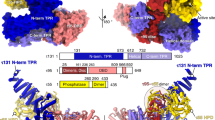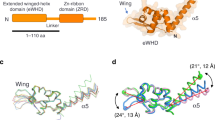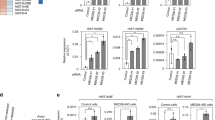Abstract
Initiation of transcription of a gene from a core promoter region by RNA polymerase II requires the assembly of several initiation factors to form a preinitiation complex. Assembly of this complex1,2 is thought to be nucleated exclusively by the sequence-specific binding of the TFIID transcription factor complex, which is composed of the TATA-binding protein (TBP) and TBP-associated factors (TAFIIs) (refs 3, 4), to the different promoters. Here we isolate and characterize a new multiprotein complex that does not contain either TBP or a TBP-like factor but is composed of several TAFIIs and other proteins. This complex can replace TFIID on both TATA-containing and TATA-lacking promoters in in vitro transcription assays. Moreover, an anti-TBP antibody that inhibits TBP- and TFIID-dependent transcription does not inhibit activity of this new complex. These results indicate that TBP-free RNA polymerase II mediated transcription may be able to occur in mammalian cells and that multiple preinitiation complexes may play an important role in regulating gene expression.
This is a preview of subscription content, access via your institution
Access options
Subscribe to this journal
Receive 51 print issues and online access
$199.00 per year
only $3.90 per issue
Buy this article
- Purchase on Springer Link
- Instant access to full article PDF
Prices may be subject to local taxes which are calculated during checkout



Similar content being viewed by others
References
Zawel, L. & Reinberg, D. Common themes in assembly and function of eukaryotic transcription complexes. Annu. Rev. Biochem. 64, 533–561 (1995).
Roeder, R. G. The role of general initiation factors in transcription by RNA polymerase II. Trends Biochem. Sci. 21, 327–335 (1996).
Verrijzer, C. P. & Tjian, R. TAFs mediate transcriptional activation and promoter selectivity [see comments]. Trends Biochem. Sci. 21, 338–342 (1996).
Chang, M. & Jaehning, J. A. Amultiplicity of mediators: alternative forms of transcription complexes communicate with transcriptional regulators. Nucleic Acids Res. 25, 4861–4865 (1997).
Brou, C.et al. Distinct TFIID complexes mediate the effect of different transcriptional activators. EMBO J. 12, 489–499 (1993).
Jacq, X.et al. Human TAFII30 is present in a distinct TFIID complex and is required for transcriptional activation by the estrogen receptor. Cell 79, 107–117 (1994).
Bertolotti, A., Lutz, Y., Heard, D. J., Chambon, P. & Tora, L. hTAFII68 a novel RNA/SSDNA-binding protein with homology to the pro-oncoproteins TLS/FUS and EWS is associated with both TFIID and RNA polymerase II. EMBO J. 15, 5022–5031 (1996).
Mengus, G.et al. Cloning and characterization of hTAFII118, hTAFII20 and hTAFII28; three subunits of the human transcription factor TFIID. EMBO J. 14, 1520–1531 (1995).
Lescure, A.et al. The N-terminal domain of human TATA-binding protein plays a role in transcription from TATA-containing RNA polymerase II and III promoters. EMBO J. 13, 1166–1175 (1994).
Usheva, A. & Shenk, T. TATA-binding protein-independent initiation: YY1, TFIIB, and RNA polymerase II direct basal transcription on supercoiled template DNA. Cell 76, 1115–1121 (1994).
Timmers, H. T. M., Meyers, R. E. & Sharp, P. A. Composition of transcription factor B-TFIID. Proc. Natl Acad. Sci. USA 89, 8140–8144 (1992).
Van der Knaap, J. A., Willem Borst, J., van der Vliet, P. C., Gentz, R. & Timmers, H. T. M. Cloning of the cDNA for the TATA-binding protein-associated factorII170 subunit of transcription factor B-TFIID reveals homology to global transcription regulators in yeast and Drosophila. Proc. Natl Acad. Sci. USA 94, 11827–11832 (1997).
Hansen, S. K., Takada, S., Jacobson, R. H., Lis, J. T. & Tjian, R. Transcription properties of a cell type specific TATA-binding protein, TRF. Cell 91, 71–83 (1997).
Crowley, T. E., Hoey, T., Liu, J. K., Jan, Y. N., Jan, L. Y. & Tjian, R. Anew factor related to TATA-binding protein has highly restricted expression patterns in Drosophila. Nature 361, 557–561 (1993).
Boam, D. S., Davidson, I. & Chambon, P. ATATA-less promoter containing binding sites for ubiquitous transcription factors mediates cell type-specific regulation of the gene for transcription enhancer factor-1 (TEF-1). J. Biol. Chem. 270, 487–494 (1995).
Nakajima, N., Horikoshi, M. & Roeder, R. G. Factors involved in specific transcription by mammalian RNA polymerase II: purification, genetic specificity, and TATA box-promoter interactions of TFIID. Mol. Cell. Biol. 8, 4028–4040 (1988).
Pugh, B. F. & Tjian, R. Transcription from a TATA-less promoter requires a multisubunit TFIID complex. Genes Dev. 5, 1935–1945 (1991).
Purnell, B. A., Emanuel, P. A. & Gilmour, D. S. TFIID sequence recognition of the initiator and sequences further downstream in Drosophila class II genes. Genes Dev. 8, 830–842 (1994).
Oelgeschlager, T., Chiang, C. M. & Roder, R. G. Topology and reorganization of a human TFIID-promoter complex. Nature 382, 735–738 (1996).
Dubrovskaya, V.et al. Distinct domains of hTAFII100 are required for functional interaction with transcription factor TFIIFb (RAP30) and incorporation into the TFIID complex. EMBO J. 15, 3702–3712 (1996).
Ruppert, S. & Tjian, R. Human TAFII250 interacts with RAP74: implications for RNA polymerase II initiation. Genes Dev. 9, 2747–2755 (1995).
Hisatake, K.et al. Evolutionary conservation of human TATA-binding-polypeptide-associated factors TAFII31 and TAFII80 and interactions of TAFII80 with other TAFs and with general transcription factors. Proc. Natl Acad. Sci. USA 92, 85–89 (1995).
Lavigne, A. C.et al. Multiple interactions between hTAFII55 and other TFIID subunits. Requirements for the formation of stable ternary complexes between hTAFII55 and the TATA-binding protein. J.Biol. Chem. 271, 774–780 (1996).
Lennon, G., Auffray, C., Polymeropoulos, M. & Soares, M. B. The I.M.A.G.E. Consortium: an integrated molecular analysis of genomes and their expression. Genomics. 33, 151–152 (1996).
Gerard, M.et al. Purification and interaction properties of the human RNA polymerase B(II) general transcription factor BTF2. J. Biol. Chem. 266, 20940–20945 (1991).
De Jong, J. & Roeder, R. G. Asingle cDNA, hTFIIA/alpha, encodes both the p35 and p19 subunits of human TFIIA. Genes Dev. 7, 2220–2234 (1993).
Tora, L.et al. The human estrogen receptor has two independent nonacidic transcriptional activation functions. Cell 59, 477–487 (1989).
Brou, C.et al. Different TBP-associated factors are required for mediating the stimulation of transcription in vitro by the acidic transactivator GAL-VP16 and the two nonacidic activation functions of the estrogen receptor. Nucleic Acids Res. 21, 5–12 (1993).
Moncollin, V., Miyamoto, N. G., Zheng, X. M. & Egly, J. M. Purification of a factor specific for the upstream element of the adenovirus-2 major late promoter. EMBO J. 5, 2577–2584 (1986).
Acknowledgements
We thank P. Chambon for support; J. C. Dantonel for help in identification and cloning of hTLF; E. Scheer for technical assistance; Y. Lutz for antibodies; D. Boam, V. Dubrovskaya, A. C. Lavigne, G. Mengus, I. Davidson and the IMAGE Consortium for reagents; H. T. M. Timmers for antibodies and for discussing unpublished results; A. Bertolotti for discussions; D. J. Heard for discussions and reading the manuscript; P. Eberling for peptide synthesis; the cell culture group for HeLa cells; R.Buchert, J.-M. Lafontaine and B. Boulay for illustrations; and A. Ozyhar for his contribution to the training of E.W. E.W. was supported by a fellowship from the Ministère de l'Enseignement Supérieur et de la Recherche. Research was supported by grants from the CNRS, the INSERM, the Hôpital Universitaire de Strasbourg, the Ministère de la Recherche et Technologie, the Fondation pour la Recherche Médicale and the Association pour la Recherche contre le Cancer.
Author information
Authors and Affiliations
Corresponding author
Rights and permissions
About this article
Cite this article
Wieczorek, E., Brand, M., Jacq, X. et al. Function of TAFII-containing complex without TBP in transcription by RNA polymerase II. Nature 393, 187–191 (1998). https://doi.org/10.1038/30283
Received:
Accepted:
Issue Date:
DOI: https://doi.org/10.1038/30283
This article is cited by
-
Maternal prenatal depressive symptoms and toddler behavior: an umbilical cord blood epigenome-wide association study
Translational Psychiatry (2022)
-
Defining the roles of PvMDH genes in response to salt stress and detailed characterization of the gene family
Journal of Plant Biochemistry and Biotechnology (2022)
-
Chronicles of the human SAGA co-activator complex
Nature Structural & Molecular Biology (2021)
-
Identification of the gene encoding the TATA box-binding protein-associated factor 1 (TAF1) and its putative role in the heat shock response in the protozoan parasite Entamoeba histolytica
Parasitology Research (2019)
-
Large normal-range TBP and ATXN7 CAG repeat lengths are associated with increased lifetime risk of depression
Translational Psychiatry (2017)
Comments
By submitting a comment you agree to abide by our Terms and Community Guidelines. If you find something abusive or that does not comply with our terms or guidelines please flag it as inappropriate.



